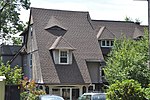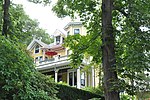Fire Station No. 7 (Brookline, Massachusetts)
Buildings and structures in Brookline, MassachusettsFire stations completed in 1898Fire stations on the National Register of Historic Places in MassachusettsNational Register of Historic Places in Brookline, MassachusettsRenaissance Revival architecture in Massachusetts

Fire Station No. 7, also known as the Washington Square Station, is a historic fire station at 665 Washington Street in Brookline, Massachusetts. Built in 1898, it is an architecturally eclectic mix of Dutch and Renaissance Revival styles. The building was listed on the National Register of Historic Places in 1985. It presently houses Engine 3 and a paramedic ambulance.
Excerpt from the Wikipedia article Fire Station No. 7 (Brookline, Massachusetts) (License: CC BY-SA 3.0, Authors, Images).Fire Station No. 7 (Brookline, Massachusetts)
Washington Street,
Geographical coordinates (GPS) Address Nearby Places Show on map
Geographical coordinates (GPS)
| Latitude | Longitude |
|---|---|
| N 42.338611111111 ° | E -71.133888888889 ° |
Address
Washington Street 676
02445
Massachusetts, United States
Open on Google Maps







